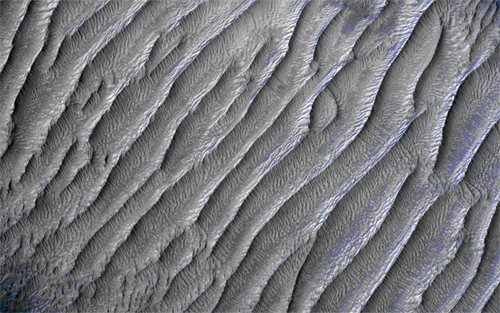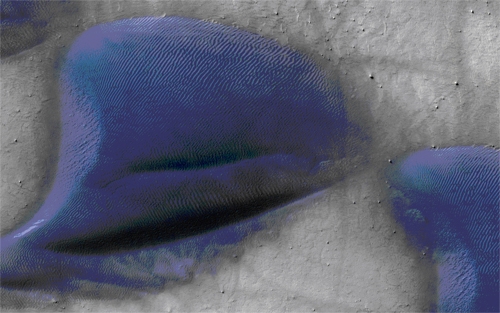Planetary scientist Dr. Lori Fenton's primary research interests include aeolian geomorphology - how wind shapes a planetary surface - for both Mars and the Earth, recent and ongoing climate changes, and the mobility of wind-blown sand and dust. Her research makes use of many different types of information, including visible and thermal imagery from spacecraft and atmospheric models such as the Ames global climate model.
Planetary scientist Dr. Lori Fenton joined the SETI Institute's Carl Sagan Center as a Principal Investigator in 2006, and was awarded NASA's Carl Sagan Fellowship for Early Career Researchers that same year. Lori's primary research interests include aeolian geomorphology - how wind shapes a planetary surface - for both Mars and the Earth, recent and ongoing climate changes, and the mobility of wind-blown sand and dust. Her research makes use of many different types of information, including visible and thermal imagery from spacecraft and atmospheric models such as the Ames global climate model.
Lori's recent publications describe how dunes and dune fields record climate change on Mars, the first evidence for dune migration on another planet, and how atmospheric models can be used to account for wind gustiness and its effects on sand movement.
Click on images for larger view
Briefly describe your research project.
I study the wind on Mars and how it affects the surface. That includes many desert features, like sand dunes. Dunes are sculpted as the wind blows around sand grains. By looking at dunes, we can learn something about wind patterns. If those wind patterns change over time, as the climate shifts, it may also be recorded in the shape of the dunes, so we might even be able to learn something about climate change on Mars by looking at sand dunes.
My current project involves looking at wind patterns in a particular area on Mars. Near Mars' equator, there is a large interconnected set of canyons. Some of them have mysterious materials, or sediments that have formed inside them that seem to indicate they were formed in the presence of water. That's very exciting since Mars is now a dry and desolate place. However, evidence like this tells us that it was once much wetter. If these materials are dried and hardened mud much like we think, then they might just have fossils in them. Finding evidence for former life on Mars would be very exciting, since we've never found life beyond Earth. Not yet, anyway.
I'm not studying those layers of old mud, but rather piles of sand that have swept by and eroded the layers. Some of that sand has accumulated into lovely dunes that can tell us something about wind patterns in these canyons. One thing we don't understand is where did this sand come from? I'm wondering if it eroded from the dried muddy layers - if that's the case then we might be able to help figure out how those muddy materials formed. Sand grains are bigger than the typical silt grains found, for example, in the middle of a peaceful lake. Maybe we can then say that these muddy materials weren't formed in a lake (or at least not a very peaceful one).
What is the coolest thing about your project?
I get to look at pretty pictures of Mars. Often I'm the first person in the world to ever look at them in detail. It's like being the first explorer to climb a mountain and see what's on the other side.
This image is part of HiRISE image PSP_002464_1745 on Mars. The sun is coming from the upper left. It shows some old eroded aeolian ("aeolian" = wind-formed) features that may have once been either dunes or ripples. The darker gray material that you can see at the upper right and lower left once buried these features, and has since eroded away, exposing these things. If you click on the link to see the whole image (which I recommend) you'll see much more of that gray material - I just pulled out the part of the image that has aeolian features in it. This sort of view is pretty rare on Earth - usually buried dunes become sandstones and never again look like dunes. Apparently on Mars, whatever process cemented these things made them much harder and thus more resistant to weathering than the gray material that covered them. That way, when the gray material erodes away, the old hardened dunes (or ripples) still hold their original shape. Source: NASA/JPL/University of Arizona
What do you currently consider your biggest challenge?
There is so much we just don't know about the geology and climatology of Mars. My job is to interpret what I see in images and observe in model results. It can be very hard to get solid answers or even narrow down possibilities. It can also be frustrating to spend months working on a really neat project, only to find that I can't really figure out anything of significant importance.
Why should the general public care about your research? What is the potential impact?
The benefits of doing this sort of research are greatly delayed, but that is the nature of much of science. Take the case of Marie Curie, who discovered two radioactive elements and pioneered the field of radioactivity. At the time it was done merely to better understand the forces controlling nature. But it opened up pathways in medicine that now, many decades after her death, allow cancer and many other diseases to be treated. And thus the most esoteric subject of physics has extended our life expectancy: whoever thought particle physics would be relevant to our daily lives? This is how science works.
My work is unlikely to save lives 100 years down the road like Marie Curie's work. She's just one famous example. The field of science is full of researchers working to understand nature. There's no way to tell what will help humanity and the world in the years to come, but some of it certainly will. In the meantime, sit back and enjoy how neat (and pretty) it is.
Can your research into sand seas of the solar system help us better understand climate change on Earth?
It could. The study of how dunes interact with wind has been used on Earth to help reconstruct past climates, and my hope is to be able to do the same on Mars, Venus, and Titan - the other worlds in the Solar System that have dunes on them. When we look at Mars, we see some types of dunes that aren't very common on Earth. In the cases where we do see the same dune types, there are some subtle differences in their shapes compared the dunes that occur on Earth. This is likely because dunes on Mars form in a very different environment. In fact it's amazing that, given that Mars is cold and has a much thinner atmosphere than Earth, we see anything recognizable at all! What Mars and the other worlds can do is broaden the range of known possibilities, so that when it comes to interpreting Earth's climate record, we have options we might not have thought about before.
How did you come to join the SETI Institute?
I finished my postdoc at Arizona State and was looking for work in the Bay Area, since my husband was in grad school at Berkeley. There is a group of atmospheric modelers at NASA Ames, so I wanted to work with them. The SETI Institute provided a good way to work with those folks (Ames doesn't hire often and I didn't have the patience to wait for them to see my genius).
What first sparked your interest in science and planetary science in particular?
I can't remember what first got me into astronomy; that goes way back, at least to first grade and possibly earlier. When I was 8 my parents gave me a dinky little telescope for Christmas. My dad took me out to look at the sky. He pointed it at Vega, a bright star. I was disappointed to see that it looked exactly the same in the telescope as it did with just my eyes. But then he pointed it at Saturn. Even with that little telescope I could see that Saturn was a disk, with rings, and even the moon Titan was visible. After that it was no contest: I had to study planets.
What motivates you?
I like to figure things out. Once I have some idea of how to approach a problem, there's no stopping me. It becomes something I must do.
What was your dream job as a child?
I wanted to be a scientist working on Mars. I still do.
This image is part of HiRISE image PSP_006248_1235 on Mars. It shows a dune at a high southern latitude that is ~150 m across. The sun is coming from the upper left - you can tell because some small boulders have shadows pointing away from the sun. The dune is blue because the image is stretched - really it would be a very dark gray. This type of dune is formed by winds blowing from the right to the left in the image. But this dune isn't likely to be active anymore - erosive processes have made the slip face on its far left side appear ragged, and the long shadowed cracks running along the dune's southern side (away from the sun) are probably caused by permafrost slowly deforming the dune. The faint thin streaks criss-crossing the image are tracks left by dust devils as they move by, vacuuming up lighter dust and leaving behind dark trails. Source: NASA/JPL/University of Arizona
If you were speaking to a group of teens about your career, what would you tell them?
Being a scientist is more than just wearing a lab coat and looking at beakers and test tubes all day. It's a very diverse sort of field, with a lot of flexibility. So if you're the kind of person who wants to answer questions about the universe around you, be aware that you can tailor your career to suit your personality. Some scientists work in the field, others develop models on computers, many work with their hands in the lab, and some process data. Some work alone, while others work on huge teams with hundreds of other people. Some are computer geeks, some are rock jocks, and some are both. Some of us are solitary quiet people, but let me tell you, there are big parties every night when we meet at professional conferences! Most of us wind up doing some combination of all of these things, but you can pick out what is most appealing to you and approach the scientific questions in your own way, playing to your strengths.
You also don't have to be a genius. Knowing your math and science is certainly necessary, but don't ever worry that you're not smart enough, like that sophomore who takes math classes at the local university (every school has at least one). Sure, there are star scientists who discover big things and get famous because they work hard and are brilliant. But even those people don't get everything right all of the time, and they can't do it all. There's plenty of room for different talents, perspectives, and approaches. If you can find your niche, you'll discover you're a part of it all. Most of us are smart people who work hard, trying to advance our field -- sometimes we make big leaps and sometimes we don't; that's just life.
My favorite thing about science is that even if your hypothesis turns out to be wrong, you've still learned something and can still contribute to humanity's understanding of the universe. Where else can you be so wrong and still win?
How do you spend your free time?
I work out - I lift weights and run. Sometimes I play video games. I hang out with friends. I read books. I take care of my son.
What is your philosophy of life?
It's better to try and fail than it is to later regret not having tried.
What is your favorite vacation destination?
Mars. Well, of places I've been to, Hawaii beaches at midnight with a full moon and a bottle of rum are pretty sweet.
If you had a one-year sabbatical to learn something entirely new, what would it be?
I wouldn't take up a new field. Instead I'd spend the year doing all the things I wish I had time to do. I'd learn to fly a plane. I've tried before, but I really need a chunk of time to dedicate to it. I'd also like to learn hang-gliding. I'd learn a martial art - the one I have in mind is krav maga, which is very practical and useful. I'd learn to surf. I'd visit someplace really unique, like India or New Zealand.
What's in store for you in the future?
Who knows? That all depends on where my funding comes from. My work is dependent upon whether or not the proposals I write are selected. If they are, then they become grants, which fund me to do the research I proposed and I get to do what I love - explore, figure things out, and bask in the beauty of our worlds.
Want to learn more? Watch Lori's interesting and informative talk on "Sand Seas of the Solar System," as presented on March 2, 2011, as part of the SETI Institute's weekly Colloquium series








